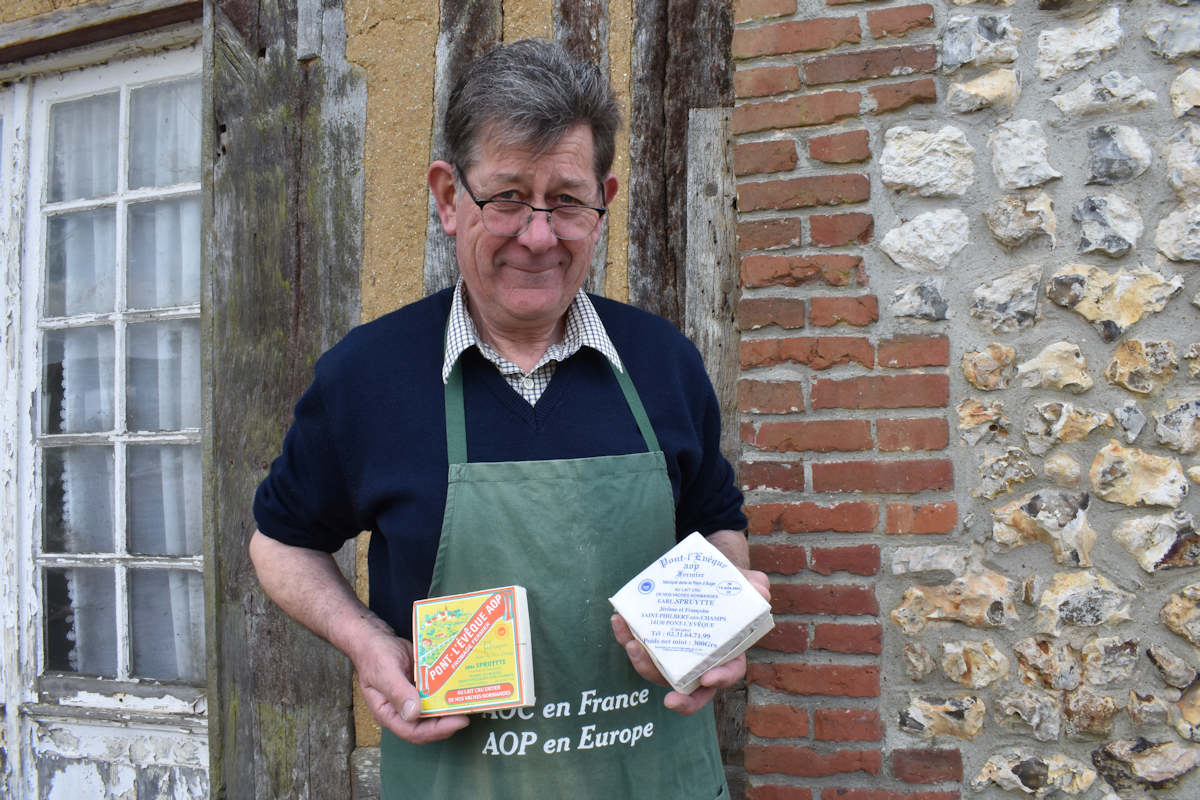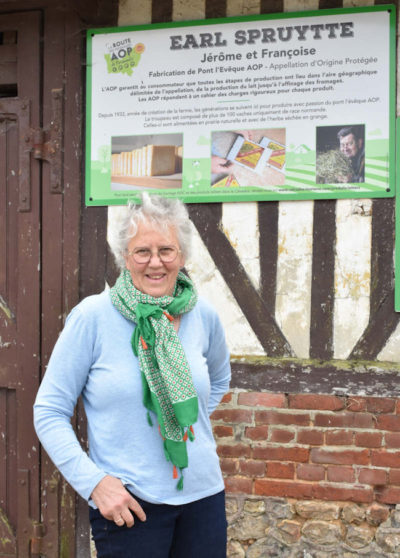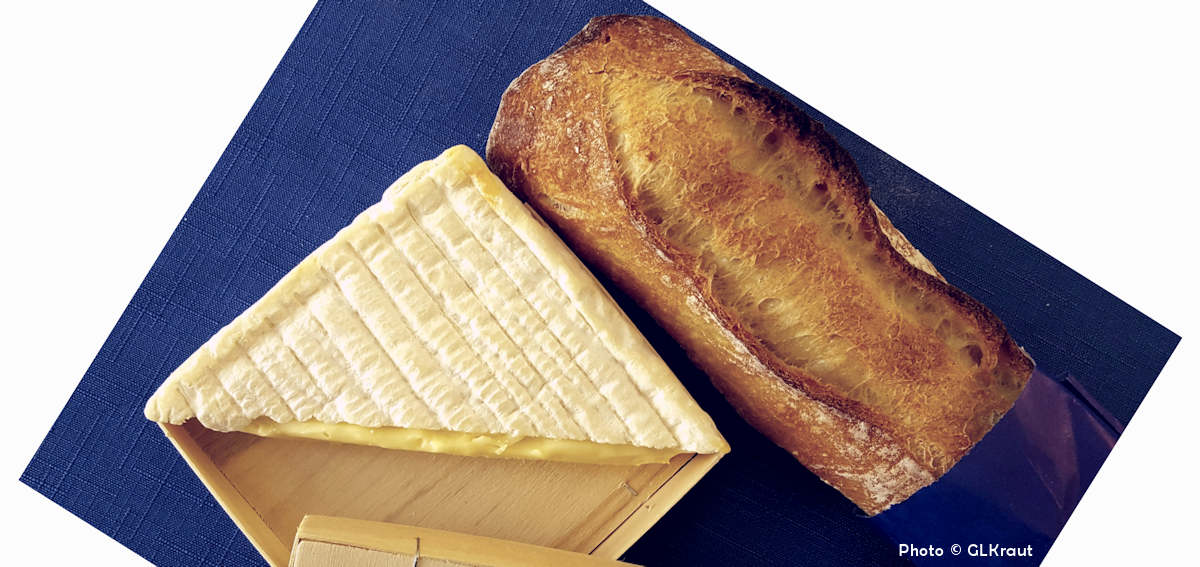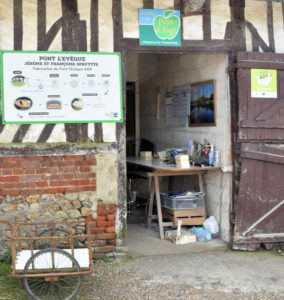
Jérôme Spruytte, producer of Pont l’Eveque fermier in Saint Philbert des Champs, Normandy. Photo GLKraut.
Oh, the people you’ll meet and the food and drink you’ll taste when you leave the main roads in Normandy! Is your destination Deauville, Honfleur and the Flowered Coast or is it Caen, Bayeux and the D-Day Landing Beaches? Either way, let’s veer off at Pont l’Evêque for several tastes of Pays d’Auge, Auge Country: cheese, beer and apple brandy. First in this three-part series, the cheese. Whether you’re a traveler in Normandy or looking for enjoyable tastes elsewhere…
Pont l’Evêque is an unremarkable town that’s lent its name to a memorable cheese. It’s one of the fab four appellation cheeses of Normandy, the others being Camembert de Normandie, Livarot and Neufchâtel. A square, soft, unpressed cheese with a washed rind and a wavy top, Pont l’Evêque can be stinky to the nose but the taste is affable. It varies, depending on the cheese’s age, from creamy mild to a soft mix of grass, leather and hay, without ever entering the stables. It comes in pasteurized and raw-milk versions. But we don’t come to Norman cow country for pasteurized cheeses.
I took a country road in search of the best and most uncommon of the raw-milk versions: Pont l’Evêque fermier. Fermier (farm-made) on the label indicates here that the cheese is made with raw cow milk whose transformation begins soon after milking, while the milk—from cows fed from the pastures and grains of the farm itself—is still warm. All, including its initial aging, is carried out on the same farm.

Meet Jérôme Spruytte, one of only a handful of devotees to producing Pont l’Evêque fermier.
Jérôme is a time-honored cheese crafter who comes from a farming tradition rather than a hipster notion of returning to the soil. His grandfather, also named Jérôme, began making cheese here in the agricultural village of Saint-Philbert-des-Champs in 1933. The current Jérôme maintains an age-old approach starting with cows with a healthy, diverse diet, fed from the farm’s own 370 acres (150 hectares) of varied pastures. Rather, he and Françoise, his wife, do since Françoise also has a hand in this, as well as being well occupied in her role as the mayor of this village of 650.
The couple lives in a house near the village church. Their farm buildings are also across the street from the church. So no need to ask for directions—find the church and you’ll find Jérôme and Françoise Spruytte’s Ferme du Bourg.

Regulations for the Pont l’Evêque appellation call for at least 50% of the milk coming from Norman cows, but the Spruyttes’ cheese is based on a herd of Norman cows only. With a herd of 100, the Spruyttes transform about 20-25% of the farm’s milk production into raw-milk Pont l’Evêque. The rest is sent to other producers in the region to be transformed into Camembert de Normandie. (Note the “de Normandie,” which designates raw-milk camembert produced in Normandy, unlike other camemberts, typically pasteurized, whether made in Normandy or not).
Using 3.6 liters (nearly a US gallon) of milk to produce one medium-size square of Pont l’Evêque, the Spruyttes make 110 cheeses per session, normally two sessions per day, 365 days per year. Call it passion, call it a way of life, call it “this is what we do.” Their Pont l’Evêque is prepared and aged in a small installation on the ground floor and basement of the building where Jérôme’s parent once lived, the oldest part of which dates from the 16th century.
After firming up in its square mold for several day, frequently being turned and positioned in phase with the room’s humidity, the shaped cheese is wrapped and moved to the basement. Aligned, the squares look like journal notebooks on a shelf, ready to record the initial passage of time. They are then taken to a second basement space for further aging. It all looks quite simple (and labor intensive). And that’s the beauty of farm-made cheese that eventually develops a personality that’s rustic to the nose and mellow to the taste.
Pont l’Evêque fermier is aged here at least 18 days (a minimum of 21 days for the larger size) before being available for sale. Most is sold after 25-28 of aging. After 30 days, Jérôme says, locals, accustomed to the availability of younger versions in the countryside, no longer want it, but Parisians do as they often prefer more aged Pont l’Evêque. As for aged versions, Jérôme says that 30-45 days is ideal for his fermier. Test the difference yourself by buying halves of two or three different ages.

Raw-milk artisanal and farm cheeses will change in taste through the year depending on what the cows have been grazing on in a particular season. The variety of pastureland at the farm makes for a rich diet from spring through fall when the cows are out grazing. Though absolute consistency isn’t the aim (like a proud parent, Jérôme welcomes the individuality of each batch, each square), the tastefulness of farm-made cheese is maintained in winter by the cows continuing to enjoy a varied winter diet of grain directly grown on the farm. He nevertheless recognizes the strain that European Union regulations put on producers such as himself as he tries to maintain “the expression of the cheese” from being standardized.
Spend 30 minutes with Jérôme and you’ll understand the earthy heart of cheesemaking as it involves land, cows, cellars and constant work. Spend 30 minutes with Françoise and you’ll want to vote for her to be your mayor, too. While the installations in the house are off-limits to visitors for health reasons, visitors are welcome for a chat and a purchase at the little shack of a shop at the farm. Don’t expect to communicate with Jérôme or Françoise in English but through curiosity. As Françoise says, “When people are interested, we always manage to communicate.”
Pick up your cheese at the farm, buy some bread in the town of Le Breuil-en-Auge (or Pont l’Evêque earlier in your day), then find yourself a spot for a picnic, for example by the beach of the Lac Terre d’Auge, outside the town of Pont L’Evêque, or simply here, by the road, by the church.
Now what to drink with this picnic? Other than for the designated driver, consider accompanying your Pont l’Evêque with Norman cidre (hard cider) or with beer produced by a local brewer whom you’ll soon also meet on these pages.
 Jérôme and Françoise Spruytte, Ferme du Bourg, 14130 Saint-Philbert-des-Champs. Tel: 02 31 64 71 99. A 15-minute drive from Pont l’Evêque. Farm shop closed on Sunday afternoons. Present at the Pont l’Evêque food market on Monday mornings.
Jérôme and Françoise Spruytte, Ferme du Bourg, 14130 Saint-Philbert-des-Champs. Tel: 02 31 64 71 99. A 15-minute drive from Pont l’Evêque. Farm shop closed on Sunday afternoons. Present at the Pont l’Evêque food market on Monday mornings.
Pont l’Evêque and surroundings have labeled their territory Terre d’Auge for tourism purposes. See the official tourist information site is terredauge-tourisme.fr. As a traveler, however, there’s no need to know the limits of this specific territory. The beautiful village of Beuvron-en-Auge is a short drive to the west. A short drive to the south is the Basilica of Lisieux, a Catholic pilgrimage destination. Official tourist information about the broader area of Calvados, one of the five departments or sub-regions that comprise Normandy, can be found here.
© 2022, Gary Lee Kraut
Also read this article about the fab four of Norman cheeses and this article about cidre (hard cider) and calvados (apple brandy) on Fance Revisited.


What a terrific piece to get to know an authentic cheesemaker, and you really get to the heart of the craft. I enjoy the mild-tasting Evêque cheese, and I recently had a cheese and bread snack on the train where I fast realized how smelly it is, and as I looked around, I spotted a youngster covering his nose. Quite delicious, though, I’ll save for the picnic.
I can well imagine that, Patsy, because I’ve also been the guilty party as a cheese-carrier on a number of train rides from Normandy to Paris. Gary